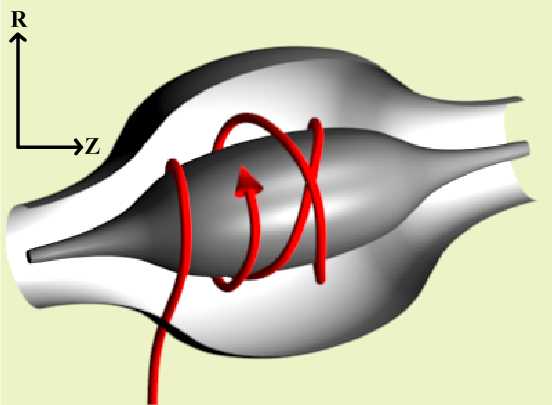5.5.7 Orbitrap
(by Nicole James) Designed in 2005 by Alexander Makarov, the Orbitrap mass spectrometer features a mass resolution of up to 150,000, high mass accuracy (2-5ppm, compared with approximately 20ppm for quadrapole systems), a mass-to-charge ratio range of 6,000 and a dynamic range larger than 1,000.
The Orbitrap works similarly to an FT ICR-MS: all ions are identified simultaneously by reading an image current of oscillations that are unique to a given mass-to-charge ratio and a Fourier transform is applied to the data to isolate individual signals. However, the Orbitrap requires no magnet, no RF field, and no excitation sequence. Despite this, Orbitrap systems generally cost at least $600,000.
Ions are first ionized by a given source; given the large m/z range, Orbitrap systems are often used to study biological molecules such as proteins, peptides, oligsaccharides—consequently, one of the most common ionization methods is ESI. The ions are then transported to a storage cell, generally a storage quadrapole, which is kept at a vacuum near 10-3 mbar. A series of transfer lenses gradually increases the electric field experienced by the ions until they are at the level of the Orbitrap.
After ions have been transferred into the Orbitrap, the system uses only electrostatic fields. The Orbitrap itself is composed of an outer “barrel“ electrode, an inner “spindle” electrode, and two endcap electrodes. Upon introduction into the Orbitrap, stable ion trajectories will result in orbiting around the center electrode while also oscillating in the z-direction. The motion in the z-direction can be described as an harmonic oscillator, which is described in equation 5.5.6.1, where w is oscillation frequency, z is the ion charge, m is the ion mass and k is the field curvature.


Figure 5.22 The Orbitrap (reprinted from WikiPedia via the GNU Free Documentation License)
While the frequency of orbiting the central electrode is also dependent on the ion’s mass-to-charge ratio, this frequency is also dependent on the ion’s energy and when it was introduced into the Orbitrap, whereas oscillations in the z-direction are independent of energy and any initial parameters. The oscillations in the z-direction are read by the image current produced on the end-cap electrodes. While all ions of a given mass to charge ratio oscillate in phase for hundreds of thousands of oscillations, small imperfections in the Orbitrap or orbital shape, along with occasionally collisions with background gas molecules (despite the 10-10 mbar vacuum) can result in the loss or displacement of some ions, ultimately resulting in a slow decrease in the intensity of the signal until it is completely lost in instrument noise. This results in a free induction decay (FID), similar to that which is acquired in NMR analysis. A Fourier Transform of the FID results in a mass spectrum.
| Frank's Homepage |
©Dunnivant & Ginsbach, 2008